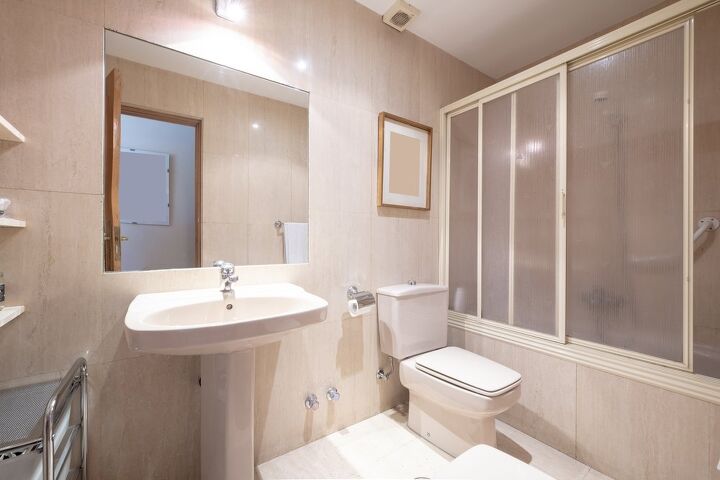Finding Beige Flags In A House

It’s the day you’ve been waiting for — move-in day. You finally closed on your new place, have the keys in hand, and become a homeowner. However, you’re starting to notice a few minor issues that might give you second thoughts. These are the little frustrations and inconveniences that many refer to as beige flags.
A disjointed color scheme, mismatched hardware, and outdated fixtures are a few of the beige flags common in a new home. Other issues are limited storage space, discolored grout, and doors without locks. Pedestal sinks and not enough electrical outlets are other problems you might not notice until after you move.
You had a home inspection, and it came back relatively clean, with no red flags to worry about. Well, beige flags might not be deal breakers or major problems, but they're still annoying.
They’re the little things you didn’t think would bother you too much when you first saw the place, but now they’re getting under your skin. Don’t let buyer’s remorse take over — there are usually a few simple tweaks you can use to banish beige flag woes.
Banish Your Home's Beige Flags
You’re excited about your new house. It seemed to be perfect when you saw it, but as the first few weeks start to go by and you start settling in, you spot a few things you didn’t notice before.
They aren’t major problems, but still, now that you’re living in your new home, you’re starting to realize things aren’t as picture-perfect as they seemed when you first made your offer. They aren’t necessarily deal breakers, but they're enough of an issue to give you second thoughts.
1. Off-Putting Color Palette
When you look at houses, you often see homes decked out in neutrals to appeal to the majority of buyers. Neutral colors allow people to better envision their own belongings in the home. However, you could also come across some homes with some rather interesting color choices (hello, bright pink bedroom).
You probably assumed you’d need to paint your new home anyway, but maybe didn’t think the color scheme would bother you so much. Maybe you thought you’d have more time before you had to break out the rollers and brushes.
But whether you’re dealing with a multi-colored nightmare or an all-white canvas that feels too cold, it’s an easy fix. Choose colors you love that work with your style and try out samples before committing to your final choices.
You can purchase sample jars for about $4 or $5. Consider the colors of things like trim, window treatments, and ceilings as well to create a cohesive color palette. Ask some friends for help and throw a pizza party or work in one room at a time on the weekends.
2. Mismatched Hardware
Maybe you didn’t pay much attention to things like door knobs and drawer pulls when you were house hunting. True enough, these things are easy to change, so they aren’t likely going to stop you in your tracks if you love the rest of the house.
But after moving in, you realize just how much the differences irk you. Brass doorknobs in the hallway, but one random chrome one in the kitchen. Rose gold pulls in the guest bathroom and black knobs in the downstairs powder room. Mixing metals can be a great design choice, but not if there’s no rhyme or reason to it.
Needless to say, this mixed-up grouping doesn’t fit well with your design. Start switching out the offending knobs and pulls as your budget allows. Make sure the hole count and spacing are the same as your existing hardware to make the switch easy. Otherwise, you’ll need to fill holes and make new ones.
3. Outdated Fixtures
It’s not uncommon to purchase a home with some outdated pieces and parts. However, suddenly the old light fixtures or builder-grade bathroom faucets are becoming real turn-offs.
You thought you could change them out later, much later. But the more you start to implement your design in your new place, the more these outdated elements stand out, and not in a good way.
Once again, taking things one step at a time is the way to make changes while maintaining your budget. Start with pieces that look the most out of place and work your way through until you’ve swapped out everything on the list.
Changing out fixtures is a fairly easy DIY project if you’re handy. But if you need to use a pro, plan to do a few at a time to maximize their time (and save your wallet).
4. Lack Of Storage
Finding out you don’t have as much storage as you thought would be a real bummer. And for many people, limited storage can be a deal-breaker. But don’t panic. If you thought the closet space was suitable when you put your offer in, then you likely can make it work.
Can you get an armoire for extra clothing storage? What about a bench at the foot of your bed to hold extra blankets? Swap out the bathroom mirror for one with a built-in medicine cabinet.
Of course, another option is to reassess your belongings. Many of us have far more items than we need. Are there a few things you can donate to charity or pass along to someone else? Decluttering and maximizing your available space can greatly increase your home’s storage capacity.
5. Discolored Grout
Dirty grout is a big turn-off. Discolored grout, even if it’s clean, also gives off some bad vibes. Then, there’s the case of grout that just doesn’t seem to go with the tile. For whatever reason your grout is less than ideal, you have several options to change it.
If it’s dirty, clean the grout with two parts baking soda and one part vinegar. If it just needs touching up in a couple of spots, try a grout pen. If it’s in really bad shape or you want to change the color, regrout your tile with lots of elbow grease and minimal cost.
Make sure to remove the old grout first. If you don’t want to do it yourself, expect to pay about $12 to $25 per square foot depending on the type of tile. In some cases, you might pay more or less.
6. Doors That Don't Lock
Checking locks on interior doors isn’t something a lot of house hunters might pay attention to. But when you’re living in your home and realize the bathroom doors don’t have locks, it could be a real inconvenience. Swap out the knobs for ones with privacy locks for a simple solution that’s easy to DIY.
7. Not Enough Electrical Outlets
This is another beige flag that won’t likely pop up until after you’re unpacking and arranging your new place. You probably didn’t count all of the electrical outlets during the house showing. Let’s face it, most of us take simple things like outlets for granted, assuming each wall will have at least one.
But soon after setting up your furniture and electronics, you realize you’re short on places to plug things in. A call to an electrician and roughly $200 will get you a new electrical outlet. If there’s an existing outlet on the other side of the wall or nearby, the job may cost less.
However, if you want to add an outlet in a location that doesn’t fit this description, it can cost more. If you need to add multiple outlets, ask if you get any type of discount. It could be more cost-effective if the electrician can do the job in one visit instead of having to make multiple trips.
8. Pedestal Sinks
Pedestal sinks look great, but they aren’t very functional when it comes to needing storage. Having nowhere to put your make-up or hair products starts to get old when you’re dealing with it every morning. A pedestal sink works great in a small powder room, but elsewhere, not so much.
Swap out a pedestal for a sink and vanity so you can gain storage and counter space. Depending on the new vanity and your existing plumbing configuration, you could do the job for as little as $600 to $800. But this project could cost over a couple of thousand, depending on your specific situation and design style.
Don't Let Beige Flags Give You Buyer's Remorse
Buying a house is a big investment, and when you start to hone in on minor imperfections and problems, you may get doubts. But don’t let beige flags stop you from loving the place that you thought was the home of your dreams. Remember, you can change these minor issues with relatively simple and affordable tweaks.
Instead of letting buyer’s remorse take over, remind yourself of all the things you love about the house. Create a plan to address what you want to change, starting with the ones that bother you the most. Then, little by little, you’ll erase the beige flags and start to reshape your house into the home you want it to be.
Related Guides:

Stacy Randall is a wife, mother, and freelance writer from NOLA that has always had a love for DIY projects, home organization, and making spaces beautiful. Together with her husband, she has been spending the last several years lovingly renovating her grandparent's former home, making it their own and learning a lot about life along the way.
More by Stacy Randall










![10 Best Electric Lawn Mowers - [2022 Reviews & Top Rated Models]](https://cdn-fastly.upgradedhome.com/media/2023/07/31/9070486/10-best-electric-lawn-mowers-2022-reviews-top-rated-models.jpg?size=350x220)



![10 Best Scroll Saws for 2022 [Ultimate Reviews & Buyer's Guide]](https://cdn-fastly.upgradedhome.com/media/2023/07/31/9070684/10-best-scroll-saws-for-2022-ultimate-reviews-buyer-s-guide.jpg?size=350x220)












